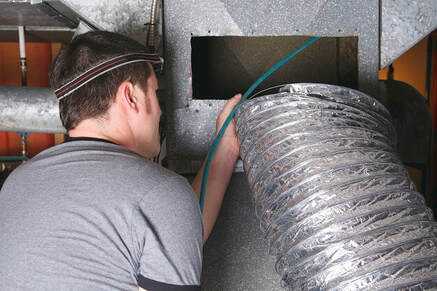|
What is air duct cleaning? Air duct cleaning is the process of removing dirt, debris, and the general filth that comes to inhabit a building's heating and cooling ducts over time. While residential air duct cleaning refers to the process as it applies to homes, commercial air duct cleaning applies to business or industrial sites, including multi-unit dwellings such as apartments or assisted-living facilities. Why is air duct cleaning necessary?
In a nutshell, debris in the HVAC (heating, ventilation, and air conditioning) system hinders air flow, and the system relies on good air flow in order to function optimally. Dirt in the air ducts spreads to other components of the HVAC system—the furnace, evaporator coil, etc—clogging up parts and reducing efficiency. In a commercial setting as well, air moving through dirty ducts is going to affect the performance of the system as a whole, which is why it is recommended that all system components be cleaned at the same time. Cleanliness of the air ducts also affects indoor air quality. Air moving through dirty ducts is eventually going to end up in the occupied space and, by extension, in your family's (or your employees') lungs. Clean air ducts mean fewer pollutants being pushed into the room through the vents. How are air ducts cleaned? Most companies offer a few different levels of service, depending on how dirty the ducts are and how long it's been since they've been cleaned. Typically the basic level of service will involve blowing air into each of the vents via a high-pressured air wand or air trigger, in combination with the negative pressure of a vacuum and a containment system to capture the debris. This basic process is usually referred to as the "push-and-pull" method. Higher levels of service will add the use of agitation tools—air whips, rotary brushes, etc—to physically sweep the walls of the ducts, dislodging debris and sending it toward the vacuum. Commercial duct cleaners will use methods similar to those of residential cleaning, with the addition of some more specialized tools, and a physical crawl-through method if duct size allows. When should air ducts be cleaned? For residential jobs, air duct cleaning is generally recommended every one to three years, depending on several factors, including whether pets are present, whether the occupants have allergies or asthma, whether remodeling or construction has recently taken place, etc. It's especially recommended after new construction or remodeling, when large amounts of dust and debris tend to be generated. Drywall dust is particularly insidious. In a commercial setting, the recommendation is roughly every 5 to 10 years. Most commercial duct cleaning companies will send a project manager to assess the condition of the air ducts and HVAC system at no cost, in order to provide an estimate for cleaning as well as a timeline for future work. When deciding to clean or not to clean, the appearance of the visible components of the duct system (vents and register covers in a residential system, diffusers and grilles in a commercial system) is a fairly reliable indicator of whether the ductwork system as a whole should be assessed for cleaning. Register covers sporting dust bunnies, for example, aren't likely to have pristine air ducts behind them. How much does air duct cleaning cost? Costs for cleaning residential air ducts are all over the map. Some companies charge per vent, while others charge by total square footage, and a lesser number will only quote a price on seeing the home firsthand. Some company-based factors that will affect pricing are technician experience (skilled techs command a higher wage) and company reputation and longevity (a well-established company can weather the seasonal highs and lows of the industry without having to slash prices in order to remain in the game). Some factors that will affect pricing for your home in particular are how large it is (or how many vents), how many systems it has (one heating or cooling unit represents one system), and which level of cleaning you choose (how dirty your ducts are). A reputable company will spell out all costs before work begins. The you-get-what-you-pay-for adage applies well here: a "$49 duct cleaning special!" will buy you the lowest tier of service and will probably apply only to the smallest of homes without surcharge. Very generally speaking, you should not expect to pay less than $400 for a quality duct cleaning on a home of average size (around 2500 sq ft according to most estimates). Wanna dig deeper? Download our free tipsheet: 10 Questions to Ask Before Hiring an Air Duct Cleaning Company. Download Tipsheet
0 Comments
|
SearchArchives
April 2022
|
Twin Cities Furnace Cleaning - Open 7 Days a Week 8AM to 8PM

